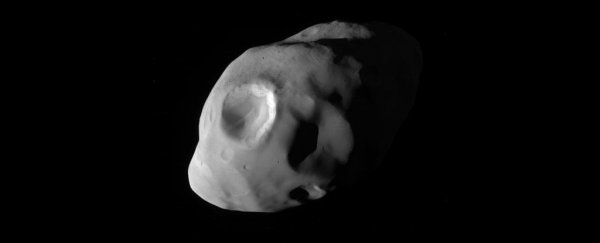NASA's Cassini spacecraft has given us to our closest ever look at Pandora - one of Saturn's smaller 'baby' moons - with the stunning new high-resolution imagery you can see above.
The new close-up follows detailed pictures taken by Cassini of Titan and Enceladus - much larger moons also orbiting Saturn - and is the latest example of how NASA's unique perspectives in space can blow our minds.
Cassini captured the image on December 18, flying within 40,500 kilometres (about 25,165 miles) of Pandora. Back in 2005, the spacecraft got within 52,000 kilometres (about 32,310 miles) of the moon for an earlier photo.
The picture was taken by Cassini's narrow-angle camera, which is part of the Imaging Science Subsystem (ISS) on board the probe.
The camera is fitted with spectral filters that span the electromagnetic spectrum and enable it to catch as much of outer space as possible.
 NASA/JPL-Caltech/Space Science Institute
NASA/JPL-Caltech/Space Science Institute
Specific targets, like Pandora, are captured by the narrow-angle camera, while a separate wide-angle camera is used for broader shots - like this dramatic look at the rings of Saturn.
As for Pandora, it measures 84 kilometres (52 miles) across, which is about 40 times smaller than our own Moon, and much smaller than Titan and Enceladus.
Based on what we know about it so far, the moon is coated in an icy dust that has largely filled in the craters that mark the rock's surface. Experts suspect it circles just outside Saturn's F ring, and may partially disrupt its position.
Pandora orbits Saturn at a distance of some 142,000 kilometres (88,235 miles), and takes a mere 15.1 hours to get around the planet.
We've known about the baby moon since it was first spotted by the Voyager 1 probe in October 1980, when it was given the less memorable name of S/1980 S 26.
It was also snapped by Voyager 2 the year after:
 Voyager 2's shot of Pandora. Credit: NASA
Voyager 2's shot of Pandora. Credit: NASA
The moon's small size makes it vulnerable to a collision that would smash it apart, but NASA says it's been able to avoid such a hit so far.
Cassini now moves on in its journey around Saturn's F ring, getting closer and closer to the massive planet.
It's going to take 22 turns around Saturn inside its rings, monitoring and photographing all the time, before crashing into the ringed planet in September 2017.
The probe will have spent almost 20 years in space by that time, and will be vaporised by the pressure and temperature of Saturn's atmosphere.
NASA decided not to crash the probe into Titan or Enceladus, just in case there's life on those moons.
Cassini has plenty more to show us between now and when its time is up, but we're already grateful for the memories.
